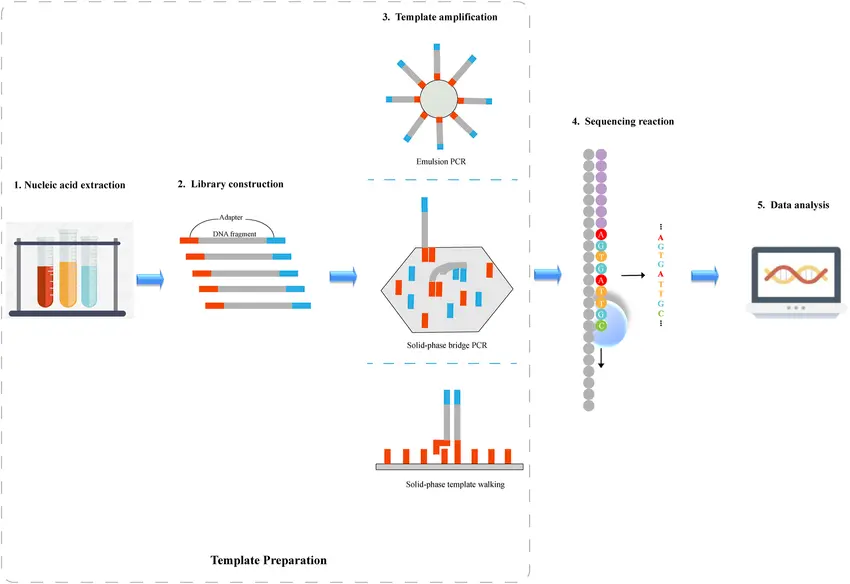Introduction
Advances in sequencing technologies have revolutionized the way researchers explore the complex world of gene regulation. Among the many molecular players, microRNAs (miRNAs) have emerged as critical regulators of gene expression. These small RNA molecules modulate the translation of messenger RNA (mRNA), influencing a wide range of cellular processes. Understanding the expression patterns and sequences of miRNAs is essential for uncovering the mechanisms underlying cellular function and regulation.
Next-Generation Sequencing (NGS) has become a cornerstone technology in molecular biology, offering unprecedented depth, accuracy, and throughput for profiling miRNAs. This blog explores how NGS enables comprehensive analysis of miRNA expression, the workflow involved, and the unique advantages this technology offers to researchers.
What Are microRNAs (miRNAs)?
microRNAs are short, non-coding RNA molecules, typically 18 to 25 nucleotides long. Unlike protein-coding genes, miRNAs do not translate into proteins. Instead, they regulate gene expression post-transcriptionally by binding to complementary sequences on target mRNAs, either triggering their degradation or inhibiting their translation.
Each miRNA can target multiple mRNAs, and a single mRNA can be regulated by multiple miRNAs, creating an intricate network of gene regulation that fine-tunes cellular activities. Due to their small size and regulatory roles, accurately profiling miRNAs provides valuable insight into cellular processes and molecular biology.
Why Profile microRNAs?
Profiling miRNAs helps researchers to:
- Identify known and novel miRNAs present in a sample
- Quantify miRNA expression levels with high sensitivity
- Detect variations and isoforms of miRNAs that could affect their function
- Explore regulatory networks in diverse biological contexts
Accurate miRNA profiling can reveal changes in gene regulation patterns, uncover molecular signatures, and provide data necessary for a broad range of biological investigations.
What is Next-Generation Sequencing (NGS)?
Next-Generation Sequencing is a high-throughput technology capable of sequencing millions of DNA or RNA fragments simultaneously. Unlike traditional sequencing methods, NGS offers large-scale, parallel processing of sequences, enabling comprehensive analysis of complex biological samples in a relatively short time.
In the context of miRNAs, NGS allows for detailed sequencing of small RNA populations, providing both sequence and quantitative expression data. This capability makes it a powerful tool for exploring the diversity and dynamics of miRNAs in any given sample.
The NGS Workflow for microRNA Profiling
Profiling miRNAs via NGS typically involves several key steps:
-
RNA Extraction
Total RNA, including small RNA species, is isolated from the biological sample. -
Small RNA Enrichment
The fraction containing small RNAs (under ~200 nucleotides) is purified to focus on miRNAs. -
Adaptor Ligation
Short DNA adaptors are attached to the ends of miRNAs to facilitate reverse transcription and sequencing. -
Reverse Transcription and PCR Amplification
The adaptor-ligated miRNAs are converted into complementary DNA (cDNA) and amplified. -
Sequencing
The prepared library is loaded onto an NGS platform where millions of sequences are read simultaneously. -
Bioinformatics Analysis
Sequencing data is processed to align reads against miRNA databases, quantify expression, and discover novel miRNA sequences.
Advantages of NGS for miRNA Profiling
NGS offers several unique benefits for miRNA research:
- Unbiased Detection: NGS can identify both known and previously undiscovered miRNAs without prior knowledge.
- High Sensitivity: Even miRNAs expressed at very low levels can be detected.
- Sequence Variant Identification: Isoforms and post-transcriptional modifications can be characterized.
- Quantitative Accuracy: Provides reliable expression level measurements across a wide dynamic range.
- Multiplexing: Multiple samples can be sequenced simultaneously using barcoding techniques.
These advantages enable researchers to obtain a comprehensive and detailed understanding of the small RNA landscape within their samples.
Applications of miRNA NGS Profiling
miRNA expression profiling by NGS can be applied to:
- Investigate gene regulation in various cell types and developmental stages
- Study responses to environmental changes in different organisms
- Explore evolutionary conservation and diversity of miRNA families
- Aid in synthetic biology by characterizing regulatory RNA components
- Support biomarker discovery and molecular signature characterization
By revealing comprehensive miRNA profiles, NGS helps unlock the complexities of gene regulation beyond what traditional methods can provide.
Conclusion
Next-Generation Sequencing has transformed the landscape of molecular biology by enabling detailed, high-throughput profiling of microRNAs. This technology’s ability to simultaneously sequence millions of small RNA molecules with high accuracy and sensitivity opens new avenues for research into gene regulation and RNA biology.
As miRNAs continue to gain recognition for their regulatory roles, NGS remains an essential tool for scientists aiming to explore these small but powerful molecules. The depth and breadth of data generated through miRNA NGS profiling provide a rich resource for expanding our understanding of molecular mechanisms and cellular function.
Further Reading
For a more technical and comprehensive review on this topic, see the article:
Next-Generation Sequencing for MicroRNA Expression Profile
To support your next-generation sequencing work, the NGS CF Control Panel G211 v1.1 is available for purchase from maxanim
